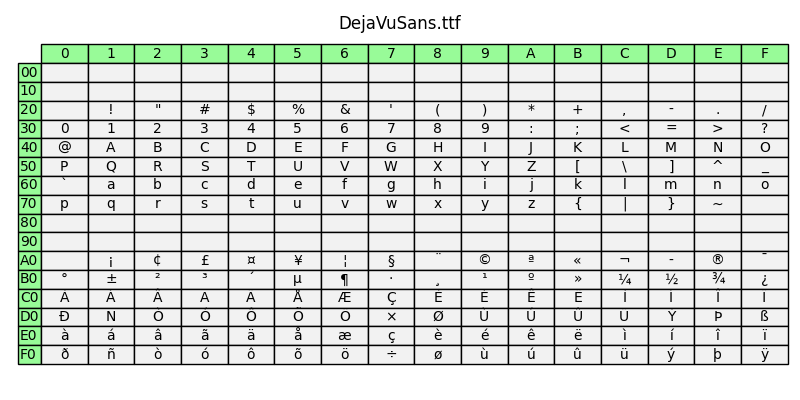Noter
Cliquez ici pour télécharger l'exemple de code complet
Tableau des polices #
La prise en charge des polices de Matplotlib est fournie par la bibliothèque FreeType.
Ici, nous utilisons tablepour dessiner un tableau qui montre les glyphes par point de code Unicode. Par souci de concision, le tableau ne contient que les 256 premiers glyphes.
L'exemple est un script de travail complet. Vous pouvez le télécharger et l'utiliser pour rechercher une police en exécutant
python font_table.py /path/to/font/file

import os
from pathlib import Path
import unicodedata
import matplotlib.font_manager as fm
from matplotlib.ft2font import FT2Font
import matplotlib.pyplot as plt
def print_glyphs(path):
"""
Print the all glyphs in the given font file to stdout.
Parameters
----------
path : str or None
The path to the font file. If None, use Matplotlib's default font.
"""
if path is None:
path = fm.findfont(fm.FontProperties()) # The default font.
font = FT2Font(path)
charmap = font.get_charmap()
max_indices_len = len(str(max(charmap.values())))
print("The font face contains the following glyphs:")
for char_code, glyph_index in charmap.items():
char = chr(char_code)
name = unicodedata.name(
char,
f"{char_code:#x} ({font.get_glyph_name(glyph_index)})")
print(f"{glyph_index:>{max_indices_len}} {char} {name}")
def draw_font_table(path):
"""
Draw a font table of the first 255 chars of the given font.
Parameters
----------
path : str or None
The path to the font file. If None, use Matplotlib's default font.
"""
if path is None:
path = fm.findfont(fm.FontProperties()) # The default font.
font = FT2Font(path)
# A charmap is a mapping of "character codes" (in the sense of a character
# encoding, e.g. latin-1) to glyph indices (i.e. the internal storage table
# of the font face).
# In FreeType>=2.1, a Unicode charmap (i.e. mapping Unicode codepoints)
# is selected by default. Moreover, recent versions of FreeType will
# automatically synthesize such a charmap if the font does not include one
# (this behavior depends on the font format; for example it is present
# since FreeType 2.0 for Type 1 fonts but only since FreeType 2.8 for
# TrueType (actually, SFNT) fonts).
# The code below (specifically, the ``chr(char_code)`` call) assumes that
# we have indeed selected a Unicode charmap.
codes = font.get_charmap().items()
labelc = ["{:X}".format(i) for i in range(16)]
labelr = ["{:02X}".format(16 * i) for i in range(16)]
chars = [["" for c in range(16)] for r in range(16)]
for char_code, glyph_index in codes:
if char_code >= 256:
continue
row, col = divmod(char_code, 16)
chars[row][col] = chr(char_code)
fig, ax = plt.subplots(figsize=(8, 4))
ax.set_title(os.path.basename(path))
ax.set_axis_off()
table = ax.table(
cellText=chars,
rowLabels=labelr,
colLabels=labelc,
rowColours=["palegreen"] * 16,
colColours=["palegreen"] * 16,
cellColours=[[".95" for c in range(16)] for r in range(16)],
cellLoc='center',
loc='upper left',
)
for key, cell in table.get_celld().items():
row, col = key
if row > 0 and col > -1: # Beware of table's idiosyncratic indexing...
cell.set_text_props(font=Path(path))
fig.tight_layout()
plt.show()
if __name__ == "__main__":
from argparse import ArgumentParser
parser = ArgumentParser(description="Display a font table.")
parser.add_argument("path", nargs="?", help="Path to the font file.")
parser.add_argument("--print-all", action="store_true",
help="Additionally, print all chars to stdout.")
args = parser.parse_args()
if args.print_all:
print_glyphs(args.path)
draw_font_table(args.path)
Durée totale d'exécution du script : (0 minutes 1,037 secondes)